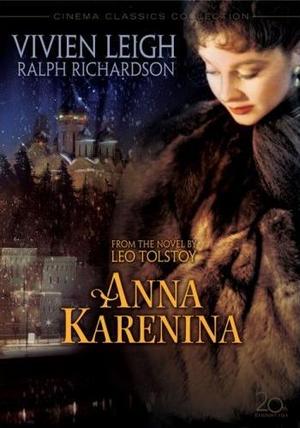The Internet Movie Database includes 24 adaptations of Anna Karenina, the very long novel Leo Tolstoi wrote between 1873 and 1877. The Florida Grand Opera just closed its first season in Miami’s new opera house with the première of David Carlson’s third opera, with a libretto by Colin Graham. Along with its beautiful and dramatic music, the Carlson/Graham opera (the second “Anna Karenina” opera in English) is notable for following the novel in giving considerable attention to the Tolstoi figure (Levin) and his beloved (Kitty).
The two best-known screen adaptations–the 1935 one with Greta Garbo in the title role, directed by her favorite, Clarence Brown, with Basil Rathbone being cuckolded by Fredric March (as, respectively, Alexei Karenin and Count Vronsky) and the 1948 one with Vivien Leigh, directed by Julien Duvivier (best known for directing “Pépé le Moko”) with Ralph Richardson and Kieron Moore as her husband and lover–pare down Levin’s role. Both are showcases for tragic star turns by iconic figures.
The camera famously loved Greta Garbo–to such a degree that I’ve never been able to form an opinion on whether she could act. I’m not even sure that she was beautiful. Definitely, she was striking and suggested mysterious depths. Vivien Leigh’s acting was often condescended to by critics as inferior to that of her husband, Laurence Olivier. Perhaps there was some merit to this invidious comparison on stage, but Leigh commanded the viewer’s eye onscreen without the trickery and mannerisms Olivier had to employ to hold attention. In that her two Academy Award-winning performances were of considerably different characters (though both were Southern belles, which Leigh was not): Scarlett O’Hara in “Gone with the Wind” (1939) and Blanche DuBois in “A Streetcar Named Desire” (1951, the next movie she made after her turn as Anna Karenina and one of only nine she made after GWTW).
Both versions dramatize the double standard in which a known adulteress is shunned by “polite” society, but in which her male partner continues to be welcomed and fidelity is not expected of men, only of women.
Both versions have rather weak Vronskys (March and Moore). Part of it may be that it is difficult to see either of the Vronskys as worth sacrificing everything to be with–not just Anna’s social station, but her beloved son, and, ultimately, her life. It’s easy to understand an attraction for Garbo or for Leigh, but difficult not to wonder what Garbo sees in March, Leigh in Moore. Garbo’s Anna seems to have more of an idea what she is risking, though both come down to 21st-century viewers as icons of vamps who lose everything in love. Garbo was on the road to “Camille” and Leigh to “Streetcar,” but at least early on in “Anna Karenina,” there is something of Scarlett O’Hara in Leigh’s Anna, whereas Garbo may eventually have laughed (though she was more laughed at in “Ninotchka”) she was never as free-spirited as Scarlett O’Hara before the war. This is to say that Leigh’s Anna has a greater arc than Garbo’s. Garbo seems tragic even when she is most in love.
While both versions have superstar Annas and Vronskys who are not only playing an unworthy character in Count Vronsky but who seem insubstantial, both versions have outstanding performances from the actors playing the husband. Richardson’s Karenin is something of a prig and a sententious, unforgiving upholder of society’s rules, but seems genuinely shocked that his wife would go with another man. Rathbone’s Karenin comes across as more worldly (cynical) and vindictive, less emotionally devastated at being betrayed, but more concerned about punishing his wife. Richardson’s Karenin seems more genuinely to love their son (played by Michael Gough) than Rathbone’s Karenin does (the son played by child star Freddie Bartholomew, whom I generally find insufferable).
Each version has outstanding performances from a supporting actress: May Robson as Vronsky’s mother in the Garbo/Brown version, Marita Hunt as Princess Betsy in the Leigh/Duvivier version.
Garbo had gowns designed by Adrian (another of her favorites), Leigh had gowns designed by Cecil Beaton, so no edge in this aspect. The music by Constant Lambert for the Leigh/Duvivier is less intrusive than that by Herbert Stothart for the Garbo/Brown one.
Garbo had her usual MGM cameraman (William Daniels, who also recurrently filmed studio boss Irving Thalberg’s wife, Norma Shearer) to photograph her the way she wanted to be photographed. Leigh was photographed by Henri Alekan (who helped launch Audrey Hepburn photographing her a few years later in “Roman Holiday”).
The Leigh/Duvivier version has better snow (and more of it) than the Garbo/Brown version. Everyone sounds British in the Leigh/Duvivier version. While most of the players in the Garbo/Brown version are British, there is the grating American sounding March and Garbo’s Swedish accent, not a smooth mixture. (No one tries to sound Russian, which is probably for the best!)
Even truncated (as it is in its current DVD release, from 139 to 111 minutes), there is a bit more development of the story in the Leigh/Duvivier version than in the slashed-to-melodrama 95 minutes of the Garbo/Brown version.
For some, less is more… but in an adaptation of a 900-page novel? Both the English-language versions are available on DVD and worth viewing. Both for her longer arc and for being more plausible as a woman crushed than Garbo is, I’d go with the Leigh/Duvier version. I also think it has a more interesting Karenin in Ralph Richardson than the more egotistical one of Basil Rathbone.
Leigh and Richardson win the matchups, but what is the clinching reason to go with them is the epilogue of March’s Vronsky regretting what happened that was tacked onto the Garbo/Brown version. Who cares whether he felt bad after destroying Anna’s life?
And, BTW, the new English-language opera version is moving from Miami to St. Louis.





